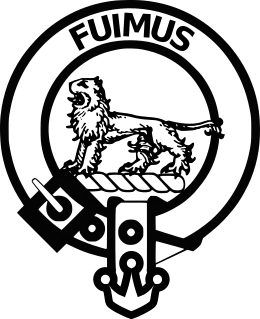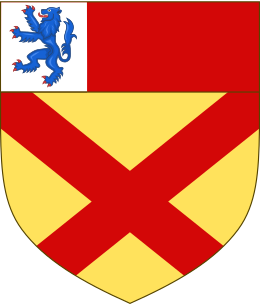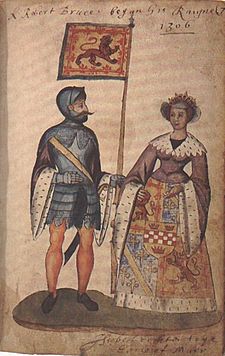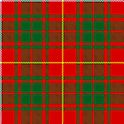Quick facts for kids Clan Bruce |
| Clann Brùs |

Crest: A lion stantan Azure armed and langued Gules
|
| Motto |
Fuimus (We have been) |
| Profile |
| Region |
Lowlands |
| District |
Fife |
| Chief |
 |
| The Rt Hon. Andrew Douglas Bruce |
| The 11th Earl of Elgin |
| Seat |
Broomhall House |
| Historic seat |
Lochmaben Castle
Clackmannan Tower |
| Septs of Clan Bruce |
|
Airth, Brews, Brix, Bruwes, Bruss, Bruc, Bruys, Brues, Brice, Bryce, Bruce, Bruice, Bruis, Bruze, Broce, Brois, Broiss, Brose, Broise, Brouss, Brus, Bruse, Brush, Carlyle, Carlysle, Cowden, Crosbie, Crosby, de Bruce, de Brus, de Brix, Leggat, Randolph, Stenhouse
|
|
|
|
|
|
|
|
Clan Bruce (Scottish Gaelic: Brùs) is a famous Scottish Lowlands clan. In the 1300s, it became a royal house, meaning its members were kings. Two kings of Scotland, Robert the Bruce and David II of Scotland, came from this clan. There was also Edward Bruce, who was a disputed High King of Ireland.
Where the Bruce Family Came From
The name Bruce comes from the French words de Brus or de Bruis. These words refer to a place in Normandy, France, now called Brix.
The Bruce family lines in both England and Scotland started with Robert de Brus, 1st Lord of Annandale. He arrived in England in 1106. Robert de Brus was a close friend of Prince David, who later became David I of Scotland. In 1124, Robert followed David north to help him claim his kingdom.
Later, a civil war started in England. David I of Scotland led an army into England. But Robert de Brus chose to join the English side. At the Battle of the Standard in 1138, he even captured his own son, who was fighting for Scotland. Robert de Brus, 1st Lord of Annandale, died in 1141.
How the Bruce Family Became Royal
The Bruce family's claim to the throne began in 1219. That year, Robert Bruce, 4th Lord of Annandale, married Isobel of Huntingdon. She was the daughter of David of Scotland, 8th Earl of Huntingdon and the niece of William the Lion, a Scottish king. This marriage brought the Bruce family a lot of wealth and land in both England and Scotland.
Their son, Robert Bruce, 5th Lord of Annandale, was known as "The Competitor." After Alexander III of Scotland died, both Bruce and John Balliol wanted to be king. Alexander's young granddaughter, Margaret, was named the heir. However, she died in 1290 while traveling to Scotland.
After Margaret's death, the Scottish leaders worried about a civil war between the Bruce and Balliol families. They asked Edward I of England to help decide who should be king. Edward I saw this as a chance to take control of Scotland. In 1292, Edward chose Balliol, who promised to be loyal to the English king. But Balliol soon rebelled against Edward. This led to Balliol's defeat and him giving up the throne after the Battle of Dunbar in 1296.
Robert the Bruce Becomes King
After John Balliol gave up the throne, Scotland had no king. Robert the Bruce first promised loyalty to Edward I. But he soon joined the Scottish fight for freedom. He later promised loyalty to Edward again, but then sided with the Scots during the Battle of Stirling Bridge.
After the English won the Battle of Falkirk, Edward I did not take Bruce's lands. It seemed Edward still hoped Bruce would join his side.
Bruce and John Comyn, who was also a rival for the throne, became leaders of Scotland after William Wallace. But their rivalry caused problems. They met at Greyfriars Church in Dumfries, a neutral place. But Bruce stabbed Comyn, killing him. Because of this, the Pope removed Bruce from the church.
Even so, Robert the Bruce was crowned King of Scotland at Scone, Perthshire in 1306. However, the English soon forced him to retreat. He tried to reach his allies, the Clan Campbell. But the Clan MacDougall, whose chief was the uncle of John Comyn, surprised Bruce. They defeated him at the Battle of Dalrigh. The king escaped but left behind a beautiful piece of Celtic jewelry, called the Brooch of Lorne. It became a treasure of Clan MacDougall.
Three years later, Robert the Bruce led three thousand experienced soldiers against the MacDougalls in Argyll. John MacDougall of Lorne set a trap for them. But in the Battle of the Pass of Brander, the MacDougalls were defeated and had to run away. The king then took the MacDougalls' lands and gave them to the Campbells for their loyalty.
Robert the Bruce led the Scottish army to a great victory at the Battle of Bannockburn in 1314. The English army was defeated.
In 1334, Thomas Bruce, who was related to the royal Bruce family, led a rebellion with Robert Stewart (who later became Robert II of Scotland) against the English.
After Robert the Bruce's Reign
Robert the Bruce's son, David II of Scotland, became king after his father died in 1329. In 1346, David marched south into England to help France, as part of the Auld Alliance. But he was defeated at the Battle of Neville's Cross and taken prisoner. He stayed in England for eleven years.
David returned to Scotland after a peace agreement. He ruled until he died unexpectedly in Edinburgh Castle in 1371. He had no children, so the throne passed to the House of Stewart.
Later, Sir Edward Bruce was made a judge in 1597. He became a Lord of Parliament with the title Lord Kinloss in 1601. Edward Bruce went with James VI to claim the English throne in 1603. He was then made a judge in England. In 1608, he was given the title Lord Bruce of Kinloss.
In 1633, his son, Thomas, became the first Earl of Elgin. When the fourth Earl died without children, the title went to the family of Sir George Bruce of Carnock. This family already held the title Earl of Kincardine. In 1747, the two Earldoms were joined.
Thomas Bruce, 7th Earl of Elgin was a diplomat and ambassador to the Ottoman Empire from 1799 to 1803. He spent a lot of money bringing marble sculptures from the Athens Parthenon out of the Ottoman Empire. These are now known as the Elgin Marbles. His son, James, was a Governor General of Canada and a Viceroy of India.
| Earls and Marquesses of Ailesbury, Earls of Cardigan, Earls of Elgin, and Earls of Kincardine family tree |
|
|
|
|
|
|
|
|
Edward Bruce of Blairhall
(c. 1505–1565) |
|
|
|
|
|
|
|
|
|
|
|
|
|
|
|
|
|
|
|
|
|
|
|
|
|
|
|
|
|
|
|
|
|
Lord Kinloss, 1602
Lord Bruce of Kinloss, 1604
Lord Bruce of Kinloss, 1608 |
|
|
|
|
|
|
|
|
|
|
|
|
|
|
Edward Bruce
(1548–1611)
1st Lord Kinloss, 1st Lord Bruce of Kinloss (1604), 1st Lord Bruce of Kinloss (1608) |
|
|
|
|
|
|
|
|
|
George Bruce of Carnock
(c. 1550–1625) |
|
Margaret Primrose |
|
|
|
|
|
|
|
|
|
|
|
|
|
|
|
|
|
|
|
|
|
|
|
|
|
|
|
|
|
|
|
|
Earl of Elgin, Lord Bruce of Kinloss, and Baron Bruce of Whorlton in the County of York, 1633 |
|
|
|
|
|
|
|
|
|
|
|
|
|
|
|
|
|
|
|
|
|
Edward Bruce
(1594–1613)
2nd Lord Kinloss, 2nd Lord Bruce of Kinloss (1604), 2nd Lord Bruce of Kinloss (1608) |
|
Thomas Bruce
(1599–1663)
1st Earl of Elgin, 3rd Lord Kinloss, 3rd Lord Bruce of Kinloss (1604), 3rd Lord Bruce of Kinloss (1608), 1st Lord Bruce of Kinloss (1633), 1st Baron Bruce of Whorlton |
|
Mary Preston |
|
George Bruce (2nd) of Carnock
(d. 1643) |
|
Robert Bruce of Broomhall
(d. 1652) |
|
|
|
|
|
|
|
|
|
|
|
|
|
|
|
|
|
|
|
|
|
|
|
|
|
|
|
|
|
|
|
|
|
|
|
|
|
|
|
| Earl of Ailesbury (1st creation), Viscount Bruce, and Baron Bruce of Skelton, 1664 |
|
Baron Brudenell of Stonton in the County of Leicester, 1628
Earl of Cardigan, 1661 |
|
Earl of Kincardine and Lord Bruce of Torry, 1647 |
|
|
|
|
|
|
|
|
|
|
|
See also: Dukes of Montrose family tree for the Earl of Kincardine 1644 creation |
|
Robert Bruce
(1627–1685)
2nd Earl of Elgin, 1st Earl of Ailesbury, 1st Viscount Bruce, 4th Lord Kinloss, 4th Lord Bruce of Kinloss (1604), 4th Lord Bruce of Kinloss (1608), 2nd Lord Bruce of Kinloss (1633), 2nd Baron Bruce of Whorlton, 1st Baron Bruce of Skelton |
|
Thomas Brudenell
(c. 1583–1663)
1st Earl of Cardigan, 1st Baron Brudenell of Stonton |
|
Edward Bruce
(d. 1662)
1st Earl of Kincardine, 1st Lord Bruce of Torry |
|
Alexander Bruce
(c. 1629–1680)
2nd Earl of Kincardine, 2nd Lord Bruce of Torry |
|
Alexander Bruce
(d. 1706)
4th Earl of Kincardine, 4th Lord Bruce of Torry |
|
|
|
|
|
|
|
|
|
|
|
|
|
|
|
|
|
|
|
|
|
|
|
|
|
|
|
|
|
|
|
|
|
|
|
|
|
|
|
|
|
|
|
|
|
|
|
|
|
|
|
|
|
|
|
|
|
|
|
|
|
|
|
|
|
|
|
|
|
|
|
Thomas Bruce
(1656–1741)
3rd Earl of Elgin, 2nd Earl of Ailesbury, 2nd Viscount Bruce, 5th Lord Kinloss, 5th Lord Bruce of Kinloss (1604), 5th Lord Bruce of Kinloss (1608), 3rd Lord Bruce of Kinloss (1633), 3rd Baron Bruce of Whorlton, 2nd Baron Bruce of Skelton |
|
Robert Brudenell
(1607–1703)
2nd Earl of Cardigan, 2nd Baron Brudenell of Stonton |
|
Alexander Bruce
(c. 1666–1705)
3rd Earl of Kincardine, 3rd Lord Bruce of Torry |
|
Robert Bruce
(d. 1718)
5th Earl of Kincardine, 5th Lord Bruce of Torry |
|
Alexander Bruce
(1662–1721)
6th Earl of Kincardine, 6th Lord Bruce of Torry |
|
Thomas Bruce
(1663–1739/1740)
7th Earl of Kincardine, 7th Lord Bruce of Torry |
|
|
|
|
|
|
|
|
|
|
|
|
|
|
|
|
|
|
|
|
|
|
|
|
|
|
|
|
|
|
|
|
|
|
|
|
|
|
| Baron Bruce of Tottenham in the County of Wilts, 1746 |
|
|
|
|
|
|
|
|
|
|
|
|
|
|
|
|
|
|
|
|
|
|
|
|
Charles Bruce
(1682–1747)
4th Earl of Elgin, 3rd Earl of Ailesbury, 3rd Viscount Bruce, 6th Lord Kinloss, 6th Lord Bruce of Kinloss (1604), 6th Lord Bruce of Kinloss (1608), 4nd Lord Bruce of Kinloss (1633), 4nd Baron Bruce of Whorlton, 3rd Baron Bruce of Skelton, 1st Baron Bruce of Tottenham |
|
George Brudenell
(1685–1732)
3rd Earl of Cardigan, 3rd Baron Brudenell of Stonton |
|
Elizabeth Brudenell
(1689–1745) |
|
|
|
|
|
|
|
|
|
William Bruce
(1710–1740)
8th Earl of Kincardine, 8th Lord Bruce of Torry |
|
|
| Earldom of Ailesbury, Viscountcy of Bruce, Whorlton Barony Bruce, Barony of Bruce of Skelton, and Lordship of Kinloss extinct, 1747 |
|
|
|
|
|
|
|
|
|
|
|
|
|
|
|
|
|
|
|
|
|
|
|
|
|
|
|
|
|
|
|
|
|
|
|
|
|
|
|
|
|
|
|
|
|
|
|
|
|
|
|
|
|
|
|
|
|
|
|
|
|
|
|
|
|
|
|
|
|
|
|
|
|
|
|
|
|
|
|
|
|
Earl of Ailesbury Buckinghamshire, Great Britain (2nd creation), 1747 |
|
|
|
|
|
|
|
|
|
|
George Brudenell, later Montagu
(1712–1790)
Duke of Montagu, Marquess of Monthermer, 4th Earl of Cardigan, 4th Baron Brudenell of Stonton |
|
James Brudenell
(1725–1811)
5th Earl of Cardigan, 5th Baron Brudenell of Stonton |
|
Robert Brudenell
(1726–1768) |
|
Thomas Brudenell-Bruce
(1729–1815)
1st Earl of Ailesbury, 2nd Baron Bruce of Tottenham |
|
|
|
|
|
Charles Bruce
(1732–1771)
5th Earl of Elgin, 9th Earl of Kincardine, Lord Bruce of Kinloss (1604), Lord Bruce of Kinloss (1608), 5th Lord Bruce of Kinloss (1633), 5th Lord Bruce of Kinloss, 9th Lord Bruce of Torry |
|
|
|
|
|
|
|
|
|
|
|
|
|
|
|
|
|
|
|
|
|
|
|
|
|
|
|
|
|
|
|
|
|
|
|
|
|
|
|
|
|
Marquess of Ailesbury, Earl Bruce of Whorlton, County of York, and Viscount Savernake of Savernake Forest, Wiltshire, 1821 |
|
|
|
|
|
|
|
|
|
|
|
|
|
|
|
|
|
|
|
|
|
|
|
|
Robert Brudenell
(1760–1837)
6th Earl of Cardigan, 6th Baron Brudenell of Stonton |
|
Charles Brudenell-Bruce
(1773–1856)
1st Marquess of Ailesbury, 2nd Earl of Ailesbury, 1st Earl Bruce, 1st Viscount Savernake, 3rd Baron Bruce of Tottenham |
|
William Robert Bruce
(1764–1771)
6th Earl of Elgin, 10th Earl of Kincardine, 6th Lord Bruce of Kinloss (1633), 10th Lord Bruce of Torry |
|
Thomas Bruce
(1766–1841)
7th Earl of Elgin, 11th Earl of Kincardine, 7th Lord Bruce of Kinloss (1633), 11th Lord Bruce of Torry |
|
|
|
|
|
|
|
|
|
|
|
|
|
|
|
|
|
|
|
|
|
|
|
|
|
|
|
|
|
|
|
|
|
|
|
|
|
|
|
|
|
|
|
|
|
|
|
|
|
|
|
|
|
|
|
|
Baron Elgin of Elgin, 1849 |
|
|
|
|
|
|
|
|
|
James Brudenell🐴
(1797–1868)
7th Earl of Cardigan, 7th Baron Brudenell of Stonton |
|
George Brudenell-Bruce
(1804–1878)
2nd Marquess of Ailesbury, 8th Earl of Cardigan, 3rd Earl of Ailesbury, 2nd Earl Bruce, 2nd Viscount Savernake, 3rd Baron Bruce of Tottenham, 4th Baron Bruce of Tottenham, 8th Baron Brudenell of Stonton |
|
Ernest Brudenell-Bruce
(1811–1886)
3rd Marquess of Ailesbury, 9th Earl of Cardigan, 4th Earl of Ailesbury, 3rd Earl Bruce of Whorlton, 3rd Viscount Savernake, 5th Baron Bruce of Tottenham, 9th Baron Brudenell of Stonton |
|
James Bruce
(1811–1863)
8th Earl of Elgin, 12th Earl of Kincardine (1647), 12th Lord Bruce of Torry, 8th Lord Bruce of Kinloss (1633), 1st Baron Elgin |
|
|
|
|
|
|
|
|
|
|
|
|
|
|
|
|
|
|
|
|
|
|
|
|
|
|
|
|
|
|
|
|
|
|
|
|
|
|
|
|
|
|
|
|
|
George John Brudenell-Bruce
(1839–1868) |
|
Henry Brudenell-Bruce
(1842–1911)
5th Marquess of Ailesbury, 11th Earl of Cardigan, 6th Earl of Ailesbury, 5th Earl Bruce of Whorlton, 5th Viscount Savernake, 7th Baron Bruce of Tottenham, 11th Baron Brudenell of Stonton |
|
Victor Alexander Bruce
(1849–1917)
9th Earl of Elgin, 13th Earl of Kincardine (1647), 13th Lord Bruce of Torry, 9th Lord Bruce of Kinloss (1633), 2nd Baron Elgin |
|
|
|
|
|
|
|
|
|
|
|
|
|
|
|
|
|
|
|
|
|
|
|
|
|
|
|
|
|
|
|
|
|
|
|
|
|
|
|
|
George William Thomas Brudenell-Bruce
(1863–1894)
4th Marquess of Ailesbury, 10th Earl of Cardigan, 5th Earl of Ailesbury, 4th Earl Bruce of Whorlton, 4th Viscount Savernake, 6th Baron Bruce of Tottenham, 10th Baron Brudenell of Stonton |
|
George William James Chandos Brudenell-Bruce
(1873–1961)
6th Marquess of Ailesbury, 12th Earl of Cardigan, 7th Earl of Ailesbury, 5th Earl Bruce of Whorlton, 6th Viscount Savernake, 8th Baron Bruce of Tottenham, 12th Baron Brudenell of Stonton |
|
Edward James Bruce
(1881–1968)
10th Earl of Elgin, 14th Earl of Kincardine (1647), 14th Lord Bruce of Torry, 10th Lord Bruce of Kinloss (1633), 3rd Baron Elgin |
|
|
|
|
|
|
|
|
|
|
|
|
|
|
|
|
|
|
|
|
|
|
|
|
|
|
|
|
|
|
|
|
|
|
|
|
|
|
|
|
|
|
|
Chandos Sydney Cedric Brudenell-Bruce
(1904–1974)
7th Marquess of Ailesbury, 13th Earl of Cardigan, 8th Earl of Ailesbury, 6th Earl Bruce of Whorlton, 7th Viscount Savernake, 9th Baron Bruce of Tottenham, 13th Baron Brudenell of Stonton |
|
|
|
|
|
|
|
|
|
|
|
|
|
|
|
|
|
|
|
|
|
|
|
|
|
|
|
|
|
|
|
|
|
|
|
|
|
|
|
|
|
|
|
|
|
|
|
|
Michael Sydney Cedric Brudenell-Bruce
(b. 1926)
8th Marquess of Ailesbury, 14th Earl of Cardigan, 9th Earl of Ailesbury, 7th Earl Bruce of Whorlton, 8th Viscount Savernake, 10th Baron Bruce of Tottenham, 14th Baron Brudenell of Stonton |
|
Andrew Douglas Alexander Thomas Bruce
(b. 1925)
11th Earl of Elgin, 15th Earl of Kincardine (1647), 15th Lord Bruce of Torry, 11th Lord Bruce of Kinloss (1633), 4th Baron Elgin |
|
|
|
|
|
|
|
|
|
|
|
|
|
|
|
|
|
|
|
|
|
|
|
|
|
|
|
|
|
|
|
|
|
|
|
|
|
|
|
|
|
|
|
David Michael James Brudenell-Bruce
(b. 1952)
styled Earl of Cardigan |
|
Charles Edward Bruce
(b. 1961)
styled Lord Bruce |
|
|
|
|
|
|
|
|
|
|
|
|
|
|
|
|
|
Heir apparent to the Marquessate of Ailesbury and Earldom of Cardigan |
|
Heir apparent to the Earldom of Elgin and the Earldom of Kincardine |
|
|
Clan Chief
The current leader of Clan Bruce is Andrew Bruce, 11th Earl of Elgin. He is very active in Scottish affairs and leads the Standing Council of Scottish Chiefs.
Bruce Family Castles
Here are some castles that belonged to the Clan Bruce:
See also
 In Spanish: Casa de Bruce para niños
In Spanish: Casa de Bruce para niños


 In Spanish: Casa de Bruce para niños
In Spanish: Casa de Bruce para niños


